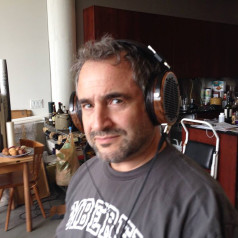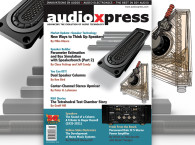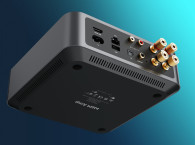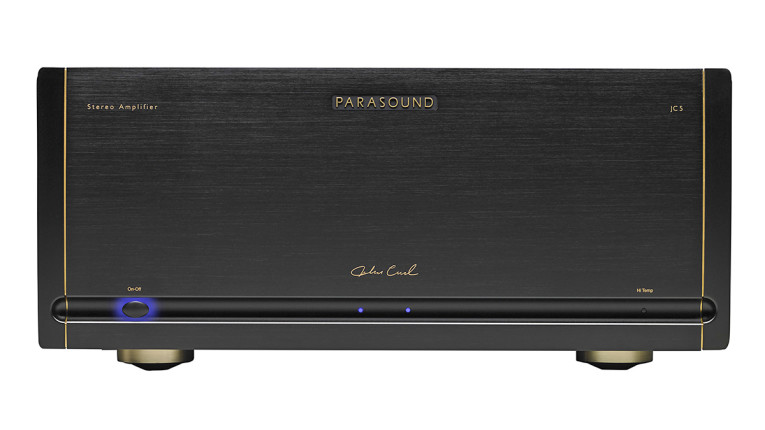
The JC 5 delivers an aggressively biased 12W into 8Ω in Class A mode, “spectacular,” according to Schram, plus 400W Class AB into 8Ω and 600W per channel into 4Ω. In stereo mode, it is stable into temporary loads as low as 1.5Ω, and can deliver 1200W into 8Ω when bridged. Full power is available down to 5Hz. Twenty-four 60MHz bipolar transistors rated at 15A each provide peak current capacity of a substantial 90A. To supply that on demand is a power supply with a 1.7kVA shielded and encapsulated toroidal transformer with a premium H18 grade steel core (for “pressure” applications) and independent windings for each channel. It has independent secondary windings for its dual-mono power supply. The beast is supplied with a premium quality, 9’, 12-gauge IEC power cord, with silver soldered connectors. In standby mode, it consumes an eco-friendly 1W.
Dual mono complementary differential JFET input stages, with extra beefy ±110VDC rails, feed dual push-pull MOSFET drive stages. As with its JC 1 grandparent, input B+/B- rails are 10V above the output rails to eliminate any chance of distortion caused by supply sagging when the amp is under load. Independent power supplies for left and right channel input stages employ 8,880µF of Nichicon Gold filter caps. Driver and output stages employ a massive 132,000µF of filtering from Rubycon.
Vampire 24-karat gold-plated RCAs offer unbalanced inputs, while discrete electronically balanced inputs via Neutrik locking XLR connectors are also supplied. RCA looped or parallel output jacks are present for daisy chaining, such as passive bi-amping or, in my case, a send out to a subwoofer transmitter. Excellent, easy torquing, 24-karat-plated five-way “propeller” binding posts are custom manufactured for Parasound by CHK Infinium. They accept up to 8-gauge bare wire.
As with most modern designs, the JC 5 employs a DC-coupled servo. It can dive well into subsonic territory, and soar into the ultrasonic. This guarantees that, in the 20Hz to 20kHz audio passband, its phase and amplitude behavior is exemplary. Schram told me, “I’m pretty happy with 100 kilohertz (bandwidth)... we don’t find extremely high bandwidth absolutely necessary.”
The user manual notes that, when the JC 5 is powered up, “...the dim blue glow around the On-Off button will become brighter and the two blue channel indicators will illuminate.” The chunky, 30A protection relays click off and... I’m not quite ready to rock. I’ve found the JC 5 takes a bit of time to come up to temperature equilibrium and sound its best. Patience is a virtue.
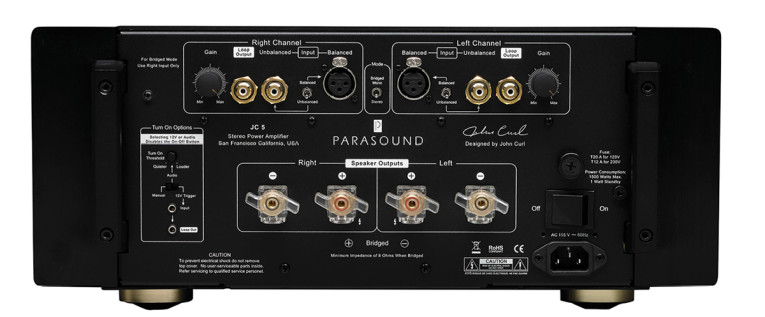
Subjectively Seen
The Parasound JC 5 has several convenient features, including input attenuation for each channel with a 29dB range, from totally off to full gain. This allowed me to optimize gain staging as I typically feed any amp directly from my exaSound e22 Mark II. Also, the inclusion of those RCA pass-thrus made a comparison between the JC 5 and the Cambridge Audio Edge W (which I reviewed in the November 2019 issue of audioXpress) much easier since I could feed both amps simultaneously.
On a variety of material, from symphonic bombast and cool blue bebop to dance floor classics and hayseed Americana, the JC 5 offered a wider, more defined soundstage, an airy extended top end and a more solid bottom. Rosen on bow was more palpable, reverb more spacious and enveloping. Improved low amplitude detail meant each instrument or voice was better delineated.
If I had to provide a pithy comment on the JC 5, I’d say clarity and control are its chief attributes. If you were listening to highly manipulated “laminated” productions, as legendary engineer George Massenburg calls it, the differences are not as noticeable. But, on even slightly more purist productions, the differences become obvious. Though my better half, Kari, preferred the casework aesthetics of the Edge W, she found the sonics of the JC 5 more compelling. To her, the Edge W was “cloudier, somewhat muddier” when listening to Amanda Shires’ HRA duet with Jason Isbell [The Problem, 96kHz/24-bit Qobuz].
With particular recordings, however, that “fuzzier, more vintage” sound was for her an asset, as with John Denver’s “Take Me Home, Country Road” [44.1 CD rip]. Not to my taste, but the shading lent an antique patina to the piece. For us both, the JC 5 offered tighter imaging with a more enveloping soundstage, crispness and more detail with a better balance between instruments while revisiting Steve Earle’s “Transcendental Blues” [44.1 CD rip]. In short, the Parasound was, according to Miss Kari, “...a lot nicer,” and this when compared to another excellent amp in its price range.
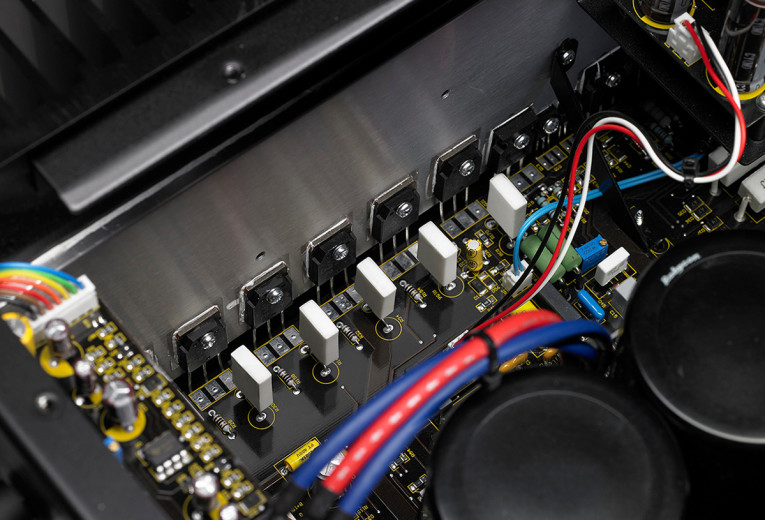
Different But the Same
At about the same power as the original JC 1, the JC 5 packs the equivalent of two into the footprint of one. Via e-mail, I asked Schram about how they differ, and what changes and/or compromises were made to accomplish that. He told me that “...the JC 5 topology is similar to the JC 1 but isn’t identical. The most obvious ‘compromise’ is the lower Class A operating range — 25W Class A in the JC 1 is the maximum possible without fan cooling. So we had to halve the Class A power in the JC 5. The filter caps are made by Rubycon and are smaller in consideration of cost and real estate. The Nichicon Gold Tune caps in the JC 1 are extremely expensive. Limited real estate limited the size of the power transformer and thus the rated power output. The -3dB low end is 5Hz, (for the) I/O (it’s) 2Hz.”
At a philosophical level, the A 21+ differs from the JC 5 mostly in the use of more expensive parts. Plus, more time was spent in refining every aspect. Schram confessed that the A 21+ is their “...current bargain of the century. One reason its price is so much lower is that we sell many more of these, as you’d expect, than the JC 5. Rather than inflate its price just because we could, we priced it to be even more attractive than the original A 21 so we could keep the large cohort of buyers for whom even $2995 is a stretch.”
Since Parasound sells both traditional analog and Class D PWM designs, I was curious to know if Schram thought that Class D performance will someday equal that of Class A. He considers Class D capable of offering outstanding performance. “When we’ve asked listeners, including pros like Jack Vad, the Producer/Senior Engineer for the San Francisco Symphony (SFS), to audition the ZoneMaster 2350 he was absolutely smitten. He has numerous A 21s and his wife’s system (she’s a cellist in the SFS) uses JC 1s driving Magnepan 3.7is. There are a lot of prejudices and commercial reasons for disparaging Class D.”
From a manufacturer’s point of view, Class D is “overly democratic.” Anyone can buy a really good quality Class D module, put it into a chassis and sell it for far less because it requires virtually no investment, overhead, or R&D. The highly specialized parts required for outstanding Class A or AB are increasingly rare. As an example, Parasound uses Toshiba 2SJ74 and 2SK170 for input stages. These parts have not been manufactured for at least 20 years.
“Only two other companies that I know of, other than Parasound,” opined Schram, “...have any (and those are)... Pass and Ayre. Parts used in Class D are largely generic and manufactured in large quantity because they have many applications outside of audio. Specialty parts for Class AB amplifiers were always a niche product and as demand dropped back in the 1980s, companies like Toshiba were happy to discontinue them (and they destroyed the tooling for the dies). The only company to attempt to emulate the Toshibas is Linear Systems. According to Curl, their best efforts for the P channel FET don’t match the venerable Toshibas.”
Familiar Territory
When I first pitched the idea of a JC 5 review, my usually sanguine audioXpress editor J. Martins asked, “What do you expect to find? It’s a John Curl MOSFET design that our readers know well. What will be the angle?” I had my views on that subject, but what to tell you, dear reader? When asked that same question, Schram was a bit sardonic. “Hmmm,” he said. “How about ‘It’s a John Curl MOSFET design that your readers know well.” Once the wink and nod had been delivered, he went on to say that, “...seriously, John is always looking at better ways to design amplifiers. The JC 5 is the best we can do to achieve virtually the same performance as a pair of JC 1s in the same real estate and less cost.” To that I’ll add, dear reader, that sometimes traditional is good. Especially in these trying times, exceptional build quality, guaranteed reliability, and accomplished execution are all virtues worth pursuing.
As I’ve mentioned before, high-end hi-fi isn’t only a rich man’s hobby but, as with cars, boats, and other luxuries, the more dollars you throw at it, the more likely you are to close in on your own image of “perfection.” The 4U, 73lb Parasound Halo JC 5 stereo amplifier carries a suggested retail price of $5,995, and includes a fine fat power cord, rear handles plus front rack mount hardware. I was unable to compare the JC 5 to unobtanium amps that start at three times the price and spiral upward in cost from there, but I can confidently say that you would have to throw down for much more to better the subjective sound quality. Your entire system — from sources to wiring to speakers — would also have to be exemplary to even match this amp’s pedigree and performance. This behemoth is worthy of unqualified admiration; highly recommended. aX
* Author’s Note:
Until the DVD-Audio format passed into irrelevance, the standard setting DVD Forum insisted that the opaque user interface was perfectly acceptable to consumers. This was despite the fact that a television was needed to reliably play the supposedly audio-centric delivery format. Even when DVD-A champions at Warner Brothers insisted that a few mandated extra buttons be added to the spec, the Forum was unwavering. In response, Parasound released the only player I know of that incorporated a tiny video display on the front panel simply to make disc navigation possible without an external display. I asked Richard Schram about that product, and was told they had “...engaged a well-known Norwegian designer to create a DVD player with the inspired model number D 1. It had a TFT display that was pretty cool. The designer overlooked the difficulty of actually manufacturing (the product) and many dollars later we had to let it go.” As an aside, I long ago sold my reference DVD-A player from my authoring days, and have since ripped all high-resolution DVD-A tracks to files on my server.
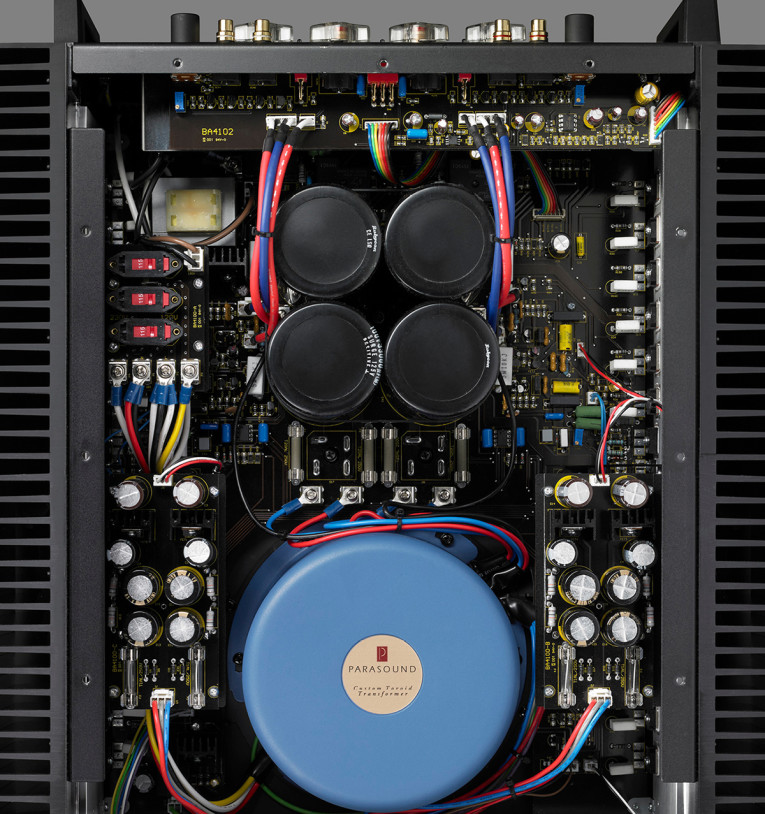
Noted designer John Curl mentioned at a seminar that he uses a JC 5. “The JC 5 is not a JC 1 exactly. There are differences, but I’m using a JC 5 pretty happily, and I’ve got $30,000 speakers and it works really well. Better than I expected really... given the trade-offs compared to the JC 1.”
Vance Dickason, editor of Voice Coil magazine (a sister magazine of audioXpress), told me he’s been a big fan of Richard Schram and his company Parasound for a number of years. “I have used HCA-800s as a measurement amp for my analyzers for at least the last 15 years. As far as my Halo P6 and A 21, they are absolutely outstanding. Also a big fan of John Curl. I listen to the equipment daily on some speakers I designed years ago for the Audax Vance Dickason Signature Series. The sound is very open, warm and musical.”
This article was originally published in audioXpress, September 2021.
Click here to read Parasound Halo JC 5: The Measurements by Stuart Yaniger
 About the Author
About the AuthorO. A. Masciarotte has spent more than 40 years immersed in the tech space, working on manufacturing, marketing, and product development for many pro and CE audio manufacturers including dbx, a/d/s, Lexicon, Sonic Solutions, and Minnetonka Audio. His client roster is as diverse as Apple, Harper Collins, NASA Johnson, NPR and Universal. His writings include a book covering file-based music for the home and more than 100 articles for sundry trade publications. A member of the Audio Engineering Society (AES), Society of Motion Picture and Television Engineers (SMPTE), Project Management Institute (PMI), and Digital Cinema Society (DCS), he is currently co-founder and CMO of MAAT Inc., a digital audio software manufacturer.



